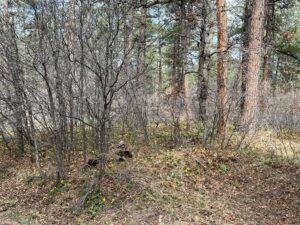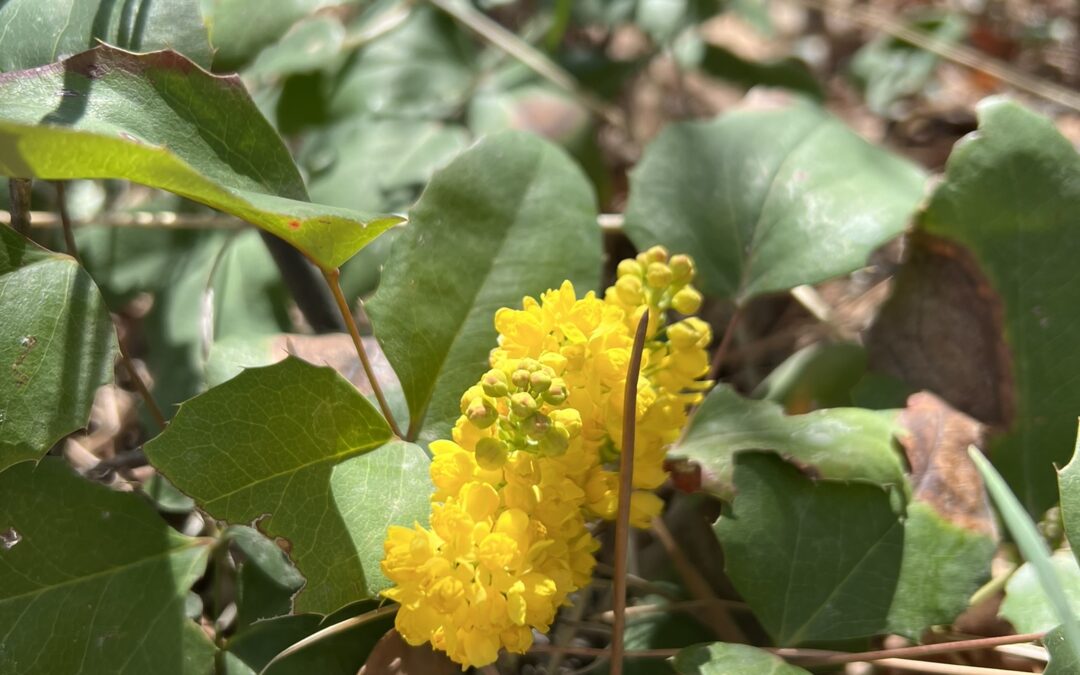By Sharon Sjostrom
If you see me wandering along the trail with dried leaves in my hair this time of year, I may have been crawling under Gambel oak to greet the Oregon grape that’s bursting out in bright yellow flowers. The Oregon grape is an evergreen shrub that’s no more than a few inches high and likes partial shade. This plant likes to grow in the understory of Ponderosa pines or Gambel oak, especially where the sun penetrates into a stand from the south.
The leaves are leathery and the shape is reminiscent of holly, so the plant is also known as holly grape. The leaves of the Oregon grape are present throughout the year. Most are dark green on top and a lighter green underneath in the spring and summer. In the fall and through the winter some of the leaves will turn a rusty brown when exposed to the sun. The Latin name is Berberis repens which literally means creeping bayberry for this low and creeping quality of the leaves. The leaves and stems are slightly poisonous to horses and cattle but are browsed by elk and deer especially in the winter when other food sources are scarce.
The scent of the flowers isn’t strong, but is fresh and slightly sweet and, in addition to me, it’s attractive to pollinators like bees, butterflies and moths. The clusters of flowers look like a group of yellow balls at first, and then open into cuplike flowers. If you look closely (I use the magnifier on my phone), you can see six little sepals on the outside surrounding six little petals. You can tell the petals from the sepals both from their position and because the tips of the petals all have a small split at the tip. Look even closer and you might be able to discern the stamens and their pollen sacs that draw in the pollinators.
Once pollinated the ovary of each flower, which is “superior” or inside the cup of petals, will mature into a small blue berry. Together, the berries look like a bunch of miniature grapes. Don’t be fooled about the looks though. Although the berries aren’t poisonous, they are very tart and don’t taste good to humans. Birds and small mammals have a different palate though and seem to love them, readily dispersing their seeds after a meal.
These plants are survivors, protectors and healers. Their woody purplish-brown stems grow from a rhizome- an underground plant stem. Forest fire? No problem. Even if the plant above ground is burned, new growth will emerge from the rhizome demonstrating for us their resilience. The plants are also known as symbol of protection. Take a look at the edges of the leaves and you’ll see the “teeth” that give them the holly-like appearance. You’ll also notice a small spine at the tip of each tooth. Small mammals will enjoy the protection from the leaves of a dense grouping of Oregon grapes. They are also known as healers. I’ve heard stories of people needing to drink untreated water while out hiking or backpacking and chewing on the roots of Oregon grape to minimize the impacts of giardia. I would recommend being better prepared so you can treat water as needed, but since the roots of Oregon grape contain isoquinoline alkaloids, it’s possible they might work to help with giardia and potentially other liver, gastrointestinal and microbial issues.
Latin repens means creeping and Berberis means bayberry. Many still know this species as Mahonia repens, where Mahonia was for Bernard McMahon, a horticulturist on the Lewis & Clark expedition and Thomas Jefferson’s gardening mentor.
Where: Dawson Butte Open Space. More than 64,000 acres are protected in Douglas County through their Division of Open Space and Natural Resources. The conservation easement on Dawson Butte is a piece of more than 27,000 acres stewarded by Douglas Land Conservancy. I am very grateful to both of these organizations for protecting open lands in the county and for providing us a place to hike and be with nature.



